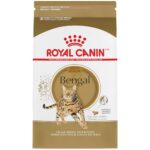Caring for a Bengal Cat: Essential Tips for Happy Pets
Bengal cats require regular grooming, a balanced diet, and ample mental stimulation. They thrive in environments rich with play and interaction.
Bengal cats, with their stunning coat patterns and high energy levels, are a captivating breed. These cats are highly intelligent and require an engaging environment to stay happy and healthy. Regular grooming helps maintain their sleek fur, while a balanced diet ensures they get the nutrients they need.
Interactive toys and activities keep their minds sharp and bodies active. Providing a variety of climbing structures and scratch posts can prevent destructive behavior. Social interaction is essential; Bengal cats enjoy spending time with their human companions. Proper care ensures these feline beauties live a fulfilling and healthy life.
Introduction To Bengal Cats
Bengal cats are popular for their stunning looks and active nature. They resemble wild leopards but are domesticated and friendly. Caring for them can be a joy and a challenge. Let’s explore their unique traits and historical background.
Unique Traits
Bengal cats have a distinctive coat that sets them apart. Their fur is often spotted or marbled, giving them a wild appearance. They are also known for their athletic build and high energy levels.
Here are some unique traits of Bengal cats:
- Playful and Active: They love to run, jump, and climb.
- Intelligent: Bengals are quick learners and can be trained easily.
- Social: They enjoy human company and get along well with other pets.
- Vocal: They communicate with various sounds and meows.
Historical Background
The Bengal cat breed originated from a cross between Asian leopard cats and domestic cats. This hybrid was created to capture the wild look while maintaining a friendly temperament.
Here’s a brief history:
- 1960s: The first Bengal cat was bred by Jean Mill in the USA.
- 1980s: The breed gained popularity and was recognized by cat associations.
- Today: Bengals are a favorite among cat enthusiasts worldwide.
The Bengal cat’s wild ancestry adds to its allure. Their history makes them unique and special pets.
Choosing The Right Bengal Cat
Choosing the right Bengal cat is crucial for a happy pet relationship. Bengal cats are known for their stunning looks and playful nature. They have specific needs and characteristics that set them apart.
Breeder Vs. Adoption
Deciding between a breeder and adoption can impact your Bengal cat experience. Both options have their advantages and considerations.
| Breeder | Adoption |
|---|---|
|
|
Adopting can be rewarding but may come with unknowns. Breeders offer more predictability but at a higher cost.
Health Checks
Before choosing a Bengal cat, ensure it has passed health checks. Healthy cats live longer and have fewer issues.
- Check for vaccinations and deworming.
- Ensure the cat is tested for genetic disorders.
- Look for signs of good health like clear eyes and a shiny coat.
Visit the cat in person if possible. Observe its behavior and ask for health records.
Choosing the right Bengal cat involves careful consideration and preparation. This ensures a happy and healthy pet for years to come.
Creating A Bengal-friendly Home
Caring for a Bengal cat involves more than just feeding and grooming. You need to create a Bengal-friendly home to keep your furry friend happy and healthy. Bengal cats are energetic and curious. They need specific environments to thrive.
Safe Spaces
Bengal cats are very active and playful. They require safe spaces to explore. Consider creating designated areas where your cat can play freely. These spaces should be free from sharp objects or toxic plants.
Use pet-safe materials for furniture and decorations. Soft cushions and blankets make great additions. Add cozy nooks where they can relax.
| Item | Purpose |
|---|---|
| Soft Cushions | Comfort and Safety |
| Blankets | Warmth and Security |
| Pet-safe Toys | Entertainment |
Climbing And Scratching Posts
Bengal cats love to climb and scratch. These activities are natural for them. Installing climbing and scratching posts keeps your furniture safe.
Place climbing posts in various locations. This gives your cat multiple options. Make sure these posts are sturdy and tall. Bengal cats enjoy vertical spaces.
Scratching posts should be made of durable material. Sisal rope is an excellent choice. It’s strong and appealing to cats. Position scratching posts near their favorite spots.
- Multiple climbing posts
- Durable scratching materials
- Strategic placement
Nutrition And Diet
Caring for a Bengal cat involves providing a balanced diet. A proper diet keeps your Bengal healthy and energetic. In this section, we will discuss the best feeding schedule and recommended foods for your Bengal cat.
Feeding Schedule
A regular feeding schedule is important for Bengal cats. They thrive on consistency. Feed them at the same times each day. This helps maintain their metabolism and digestion.
Bengal kittens need to eat more frequently. Feed them small meals 4-5 times a day. Adult Bengals can eat 2-3 times a day. Always provide fresh water alongside their meals.
| Age | Feeding Frequency |
|---|---|
| Kitten (up to 6 months) | 4-5 times a day |
| Adult (6 months and older) | 2-3 times a day |
Recommended Foods
A Bengal’s diet should be rich in protein. Here are some recommended foods:
- High-quality dry kibble: Choose kibble with high protein content.
- Wet food: Wet food provides hydration and variety.
- Raw diet: Consult your vet before starting a raw diet.
Avoid foods with fillers like corn and soy. These do not provide necessary nutrients. Always read the ingredient list on cat food packages.
You can also offer occasional treats. Ensure they are healthy and low in calories. Overfeeding treats can lead to obesity.
Monitor your Bengal’s weight and adjust portions as needed. Each cat is unique, and their diet should cater to their specific needs.
Exercise And Play
Bengal cats are highly active and intelligent creatures. They need regular exercise and play to stay happy and healthy. Providing your Bengal cat with proper activities can prevent boredom and destructive behavior.
Interactive Toys
Interactive toys are essential for Bengal cats. These toys keep them engaged and stimulate their minds. Here are some popular options:
- Laser pointers: Bengals love chasing the light.
- Feather wands: These mimic the movement of birds.
- Electronic toys: Automated toys can provide hours of fun.
Rotate these toys regularly. This keeps the interest alive and prevents boredom.
Daily Playtime
Daily playtime is crucial for your Bengal cat’s well-being. Aim for at least 30 minutes of active play each day. Break this into shorter sessions if needed.
Here are some tips for effective playtime:
- Set a schedule: Consistency helps establish a routine.
- Use a variety of toys: Keep the sessions exciting and varied.
- Incorporate climbing: Bengals love to climb and explore heights.
Engage in activities that mimic hunting behaviors. This satisfies their natural instincts.
Remember, a tired Bengal is a happy Bengal. Regular play and exercise ensure a content and well-behaved pet.
Grooming And Hygiene
Keeping your Bengal cat clean and well-groomed is vital. It ensures their health and happiness. Grooming also strengthens your bond with your feline friend. Bengal cats are known for their beautiful coat and playful nature. Proper grooming and hygiene practices are essential to maintain their stunning appearance and well-being.
Coat Care
The Bengal cat’s coat is sleek and soft. It requires minimal grooming. Regular brushing helps remove loose fur. It also prevents hairballs. Use a soft-bristle brush for this task. Brush your Bengal cat once or twice a week. Bathing is rarely needed. Bengals are good at keeping themselves clean. If a bath is necessary, use cat-friendly shampoo. Ensure the water is lukewarm. Dry them thoroughly afterward.
Dental Hygiene
Dental hygiene is crucial for Bengal cats. It prevents dental diseases. Brush your cat’s teeth regularly. Use cat-specific toothpaste. Introduce tooth brushing gradually. Start with gentle, short sessions. Offer dental treats to support oral health. Regular vet check-ups are important. The vet can clean your cat’s teeth professionally. This helps prevent plaque and tartar build-up.
Health And Wellness
Caring for a Bengal cat involves ensuring their health and wellness. These cats are active and need regular check-ups to stay healthy. Below are some key aspects of maintaining your Bengal cat’s health and wellness.
Regular Vet Visits
Regular vet visits are essential for your Bengal cat’s health. Schedule a check-up every six months. This helps catch any health issues early. During these visits, the vet will examine your cat’s eyes, ears, and teeth. They will also check their weight and overall condition.
- Check-up every six months
- Eyes, ears, and teeth examination
- Weight and overall condition check
Common Health Issues
Bengal cats may face some common health issues. Being aware of these can help in early detection and treatment. Below are some health issues to watch out for:
| Health Issue | Description |
|---|---|
| Hypertrophic Cardiomyopathy (HCM) | A heart condition affecting Bengal cats. |
| Progressive Retinal Atrophy (PRA) | A genetic disorder leading to blindness. |
| Patellar Luxation | A knee joint issue causing discomfort. |
Regular vet visits can help detect these issues early. Keeping an eye on your cat’s behavior and condition is also vital. If you notice any changes, consult your vet immediately.
Training And Behavior
Caring for a Bengal cat involves understanding their unique training and behavior needs. Bengal cats are intelligent and active. They need proper training and behavior management to live happily. Let’s explore some key aspects of training and behavior in Bengal cats.
Litter Training
Litter training a Bengal cat is straightforward. Start by placing the litter box in a quiet, accessible location. Use a clean, unscented litter that the cat likes. Show the cat the box and gently place them inside. Repeat this after meals and naps.
Bengal cats are usually quick learners. They often pick up litter training faster than other breeds. Keep the litter box clean to encourage consistent use. If your Bengal cat has accidents, check for underlying health issues.
Behavioral Challenges
Bengal cats can exhibit some behavioral challenges. They are very energetic and curious. This can sometimes lead to problems.
Common behavioral issues include:
- Scratching furniture
- Climbing curtains
- Excessive vocalization
- Chewing on items
To manage these behaviors, provide plenty of toys and scratching posts. Regular play sessions help channel their energy. Use positive reinforcement to encourage good behavior.
If your Bengal cat shows aggressive behavior, consult a vet or a cat behaviorist. Understanding their needs and providing a stimulating environment can reduce behavioral issues.
Training and managing a Bengal cat’s behavior require patience. With proper care, they become loving and well-behaved pets.
Socialization And Companionship
Caring for a Bengal cat requires special attention to their socialization and companionship needs. These cats are highly social and thrive on interaction. A well-socialized Bengal cat is happier and healthier. This section will cover how to introduce your Bengal to other pets and the importance of human interaction.
Introducing To Other Pets
Bengal cats can get along well with other pets if introduced properly. Follow these steps for a smooth introduction:
- Separate Spaces: Start by keeping them in separate rooms.
- Scent Exchange: Swap bedding to familiarize scents.
- Visual Introduction: Allow them to see each other through a baby gate.
- Supervised Meetings: Arrange short, controlled meetings.
- Gradual Increase: Slowly increase the time they spend together.
Always monitor their interactions closely. Look for signs of stress or aggression. If needed, consult a vet for advice.
Human Interaction
Bengal cats crave human interaction. They are affectionate and enjoy being around people. Here are some tips to ensure quality time with your Bengal:
- Playtime: Engage in interactive play sessions daily.
- Training: Teach them tricks to stimulate their minds.
- Petting: Regular petting sessions build a strong bond.
- Talk to Them: Bengals respond well to verbal interaction.
- Quality Time: Spend time watching TV or reading with them nearby.
Use toys, treats, and affection to keep your Bengal cat happy. Remember, a well-socialized cat is a joy to have.
Traveling With Your Bengal
Bengal cats are adventurous and curious by nature. They love exploring new environments. Traveling with your Bengal can be a rewarding experience. It strengthens your bond and provides mental stimulation for your pet. Whether it’s a short car trip or a vacation, there are steps to ensure your Bengal’s safety and comfort.
Car Travel Tips
Car travel can be stressful for any cat. Proper preparation helps make the journey smoother. Below are some tips to ensure a safe and enjoyable car trip for your Bengal.
- Secure Carrier: Always use a secure carrier for your cat. Place it in a stable position in the car.
- Comfortable Bedding: Line the carrier with soft bedding. This helps your Bengal feel cozy.
- Hydration: Ensure your cat stays hydrated. Offer water during breaks.
- Ventilation: Keep the car well-ventilated. Avoid direct sunlight on the carrier.
- Regular Breaks: Take breaks every 2-3 hours. Let your Bengal stretch and use the litter box.
Vacation Preparations
Planning a vacation with your Bengal requires some extra steps. Make sure your cat is ready for the adventure. Here’s how to prepare:
- Health Check: Schedule a vet visit. Ensure your Bengal is healthy for travel.
- Microchip: Microchip your cat. This helps in case they get lost.
- Travel Kit: Pack a travel kit. Include food, water, bowls, and litter essentials.
- Comfort Items: Bring familiar items. Include toys and blankets to reduce stress.
- Accommodation: Ensure your destination is pet-friendly. Confirm the availability of pet amenities.
Traveling with your Bengal can be a joyous experience. With proper planning and care, you can make the trip comfortable and enjoyable for both you and your furry friend.
Frequently Asked Questions
What Is The Diet Of A Bengal Cat?
A Bengal cat’s diet should include high-quality protein, wet food, and occasional raw meat.
How Often Should I Groom A Bengal Cat?
Grooming a Bengal cat weekly is usually sufficient to keep their coat healthy and shiny.
Are Bengal Cats Good With Children?
Yes, Bengal cats are typically friendly and playful, making them good companions for children.
Do Bengal Cats Need Special Toys?
Bengal cats are active and intelligent; interactive toys and climbing structures are recommended.
How To Litter Train A Bengal Cat?
Start by placing them in the litter box after meals and naps to encourage use.
Do Bengal Cats Require Regular Vet Check-ups?
Yes, annual vet check-ups are essential to monitor their health and prevent diseases.
Can Bengal Cats Live With Other Pets?
Yes, they can coexist with other pets if introduced properly and given time to adjust.
How Much Exercise Does A Bengal Cat Need?
They need daily exercise, including playtime and interactive activities, to stay healthy and happy.
Do Bengal Cats Have Specific Health Issues?
Bengal cats can be prone to genetic conditions like hypertrophic cardiomyopathy and progressive retinal atrophy.
What Environment Is Best For A Bengal Cat?
A stimulating environment with plenty of toys, climbing spaces, and mental challenges is ideal for Bengal cats.
Conclusion
Caring for a Bengal cat requires attention, love, and understanding of their unique needs. Provide a balanced diet and regular vet check-ups. Engage them with interactive toys to keep them stimulated. Ensure a safe and enriched environment. By doing so, you’ll have a happy, healthy, and loving Bengal cat companion.




